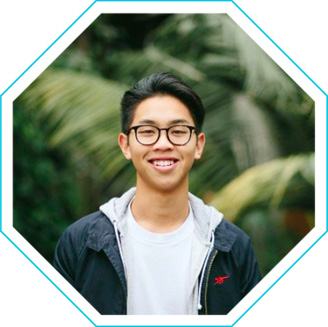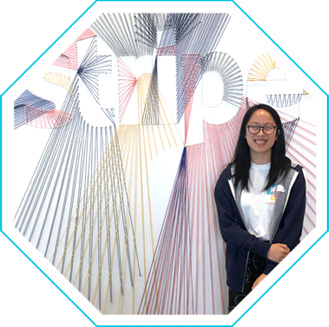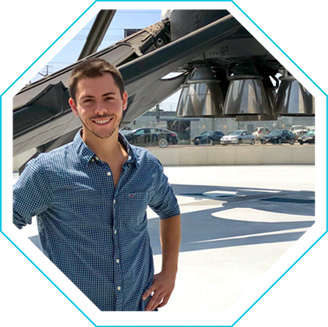
With school officially in summer session, we caught up with a few of our students to find out what they are up to. From volunteering to internships, not surprisingly, many are spending time engineering change.

Nathan Long
Fourth-Year, Mechanical Engineering
Nathan Long, a fourth-year mechanical engineering student, wanted to take a step back from engineering and explore an entirely non-technical direction this summer. By joining the Teach for America Accelerate Fellowship and finding himself in a new part of the country every two weeks, tackling some of education’s toughest problems, he did just that.
Founded in 1989, Teach for America’s mission is to recruit college graduates from top universities across the United States to serve as teachers in one of 52 low-income communities that the organization serves.
So far, Teach for America has sent Long to Albuquerque, Nashville, and Chicago to work as an education consultant.
“We go to three different places and first learn about the education landscape, what the schools are like, what the populations are like,” Long said. “We then contribute by supporting these communities to address educational inequity.”
Long’s summer started in New Mexico, where he and three students from other universities across the country worked with a charter school whose student body was mostly Native American. School officials wanted to find out why a relatively large number of high school students were failing classes during the year, which required them to take summer school, and what they could do to help boost the students’ grades.
Long and his teammates went to work interviewing students, teachers, and administrators. They found that many students were lacking basic study and organizational skills, and that institutional communication was spotty. Their solution, which will be implemented when the students return to school in September, is to have a competition within the grades based on homework completion and attendance. They also designed a system for teachers to actively track subjects that students are struggling with and their progression.
Long says that the most enjoyable part of this experience has been inspiring the students. After suggesting to one boy who wanted to be a baker that he should attend college to understand the science of baking, Long later overheard the boy say he wanted to now become a scientist.
This summer, Long learned not only about the education landscape in America, but also realized that whatever he does in life has to involve people. “Doing this fellowship was kind of jumping into the deep end of something I didn’t understand. But it’s paid off immeasurably for me. I would advise other students to simply take the leap,” he said.

Yvonne Chen
Third-Year, Computer Science
As the current president of the UCLA Association for Computing Machinery, the largest computer science student organization at UCLA, junior Yvonne Chen’s growing list of accomplishments also includes a summer internship as a software engineer at Stripe, which provides online payment systems.
“I’m using machine learning and natural language processing to work with different types of international payments throughout Europe and Asia,” she said. “It’s interesting and extremely varied work, and can range from redirecting the payment flow to Stripe to detecting prohibited businesses the company does not want to engage with.”
Chen found two Samueli classes in particular, CS 111 Operating Systems and CS 131 Programming Languages, have come in handy while at Stripe.
“I found CS 111 useful in understanding design patterns, and it helped me to recognize problems like inconsistent state across distributed systems and reduce them into simpler issues,” Chen said. “CS 131 is helpful in learning how to pick up computer programming languages rapidly, which helped me learn Ruby and Go, two languages that I’ve used so far in my internship that were previously unfamiliar to me.”
While her technical expertise is rapidly growing, one of her main goals at UCLA is to build an inclusive and supportive community around computer science at Samueli and across the campus.
Before becoming president of UCLA ACM last year, she led the organization’s ACM Hack subgroup, where she held Hack on the Hill, marketed as “a beginner’s first hackathon.” The event was geared toward those who never applied to hackathons for fear of being rejected due to a lack of computing know-how.
“By holding quarterly boot camps known as Hack School for Web, Android, and iOS development, I was hoping to even the playing field between those who had real project experience and those who didn’t,” she said. “The tagline we came up with for Hack School was ‘8 weeks: 0 to Hero,’ and I aimed to make retention a priority so that our initial group of 150 attendees felt welcome enough to keep coming back.”
She previously interned at Adobe, and also gave a hand as lead front-end developer for Pomily, a UCLA-based startup focused on beauty and makeup. Next year, she hopes to find a product management internship and also continue her own entrepreneurial pursuits.
As for her plans after graduation: “I have to be practical about what I do, and I will likely start off in Silicon Valley, although I am sure that is not where I am going to leave off.”

Dylan Dickstein
MS ’17, Doctoral Student, Aerospace Engineering
As a five-year-old boy enthralled with model rocket kits that his parents brought home, aerospace engineering doctoral student Dylan Dickstein had no idea back then that the summer of 2018 would find him working as a propulsion engineer at SpaceX.
A recipient of the 2018 Graduate Research Fellowship from the National Science Foundation, Dickstein is researching erosion from high heat flux in microengineered materials for space exploration in pursuit of his Ph.D. Correspondingly, at SpaceX, he is conducting structural and fluid analyses on propulsion systems for the company’s SuperDraco engines on its Crew Dragon spacecraft.
Dickstein’s penchant for rocketry started early when he quickly outgrew the rocket kits and started designing his own high-powered prototypes. By the time he entered high school, he was captivated with building and launching amateur rockets powerful enough to jet several miles into the atmosphere.
His proudest moment was during his sophomore year at Cal Poly San Luis Obispo when he designed, built, and launched the largest rocket ever flown at the campus to attempt the final step of the three-part certification for his high-power rocket license.
Eight months of development and fabrication were topped off with a last-minute coat of spray paint and a bumpy drive through a fallow field outside of Fresno. The rocket roared to over a mile in altitude and reached a maximum speed on par with commercial aircraft.
“Creating a custom rocket of this magnitude that satisfied all the requirements set by the National Association of Rocketry and the Tripoli Rocketry Association was amazing and cemented my decision to pursue a master’s and doctoral degree in aerospace engineering at UCLA,” he said.
The launch marked a turning point in Dickstein’s aerospace career as he dialed back amateur rocketry to focus on graduate-level research at Samueli and explore opportunities in the industry.
In addition to SpaceX, Dylan has racked up experience at United Launch Alliance, Virgin Galactic, and The Aerospace Corporation.
“While the rockets I work on now may be orders of magnitude larger than those that got me interested in aerospace, the physics and mathematical principles are identical. I find the work exciting, challenging, and incredibly rewarding.”
